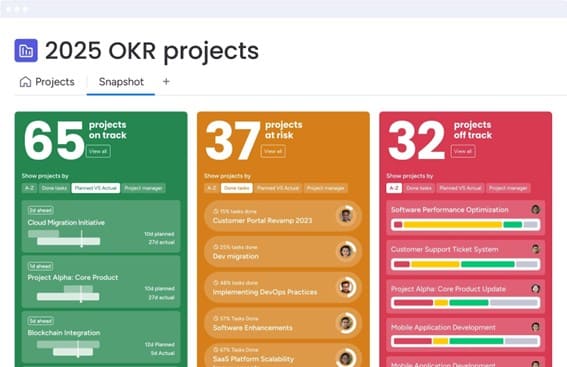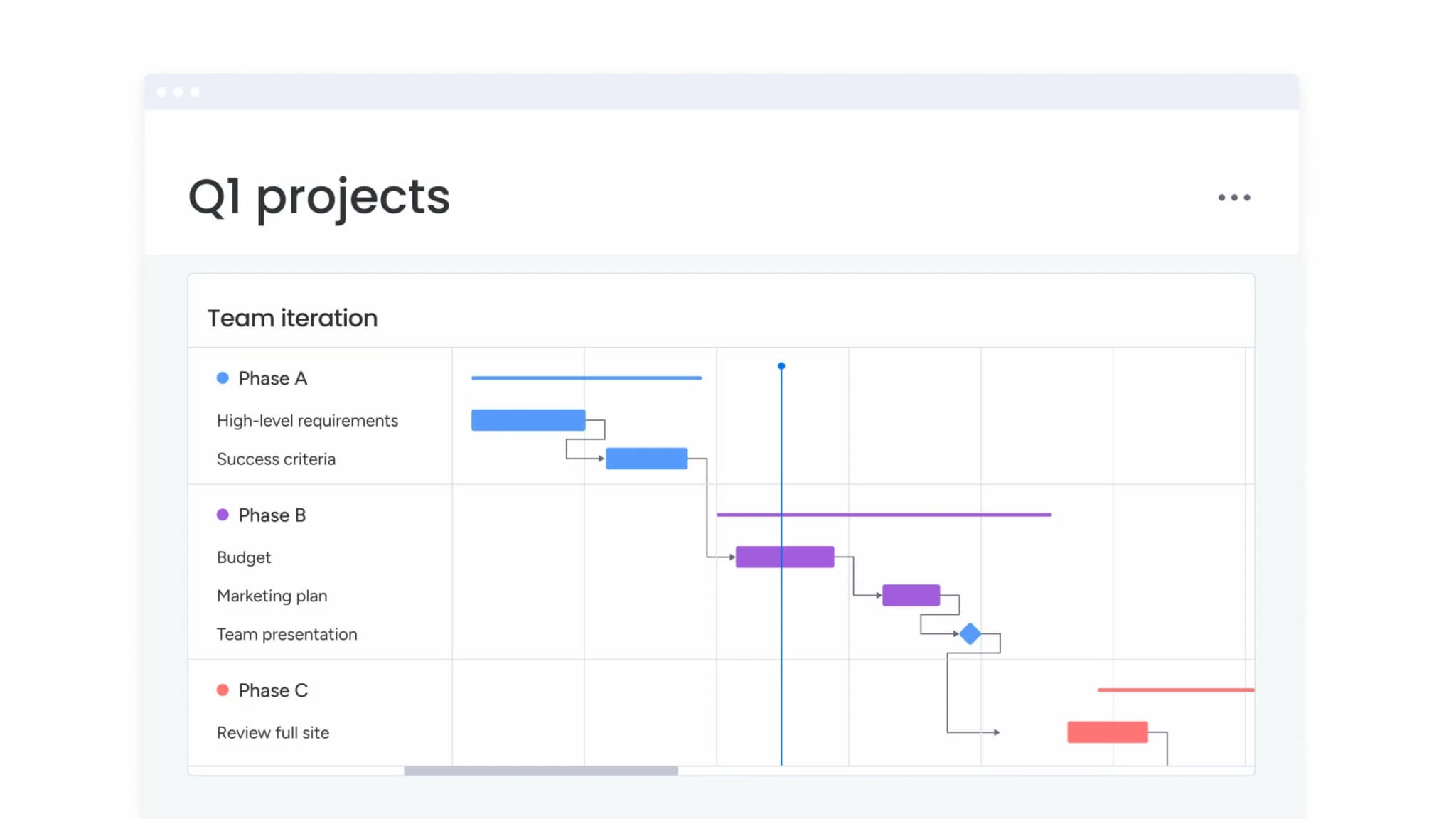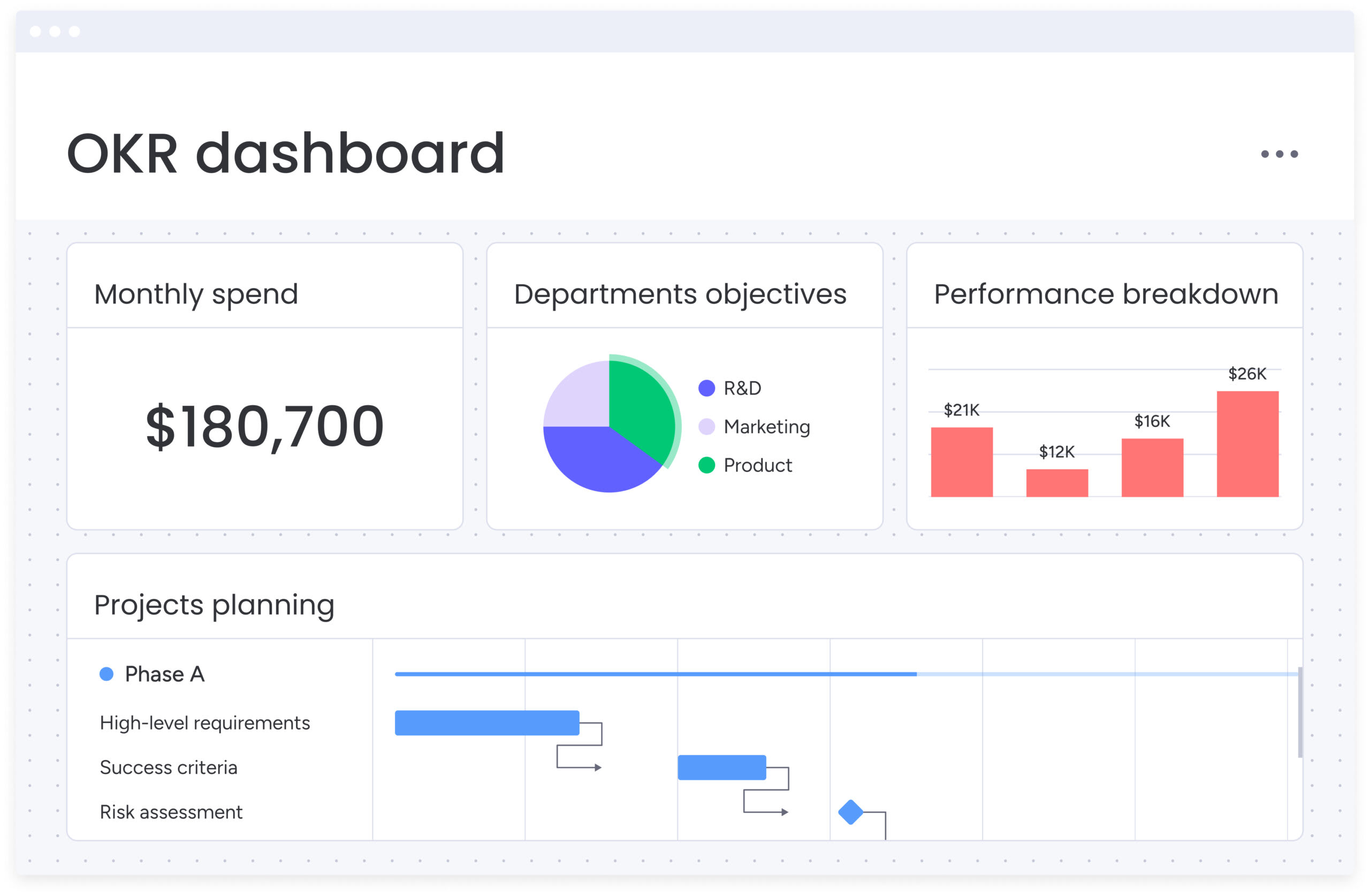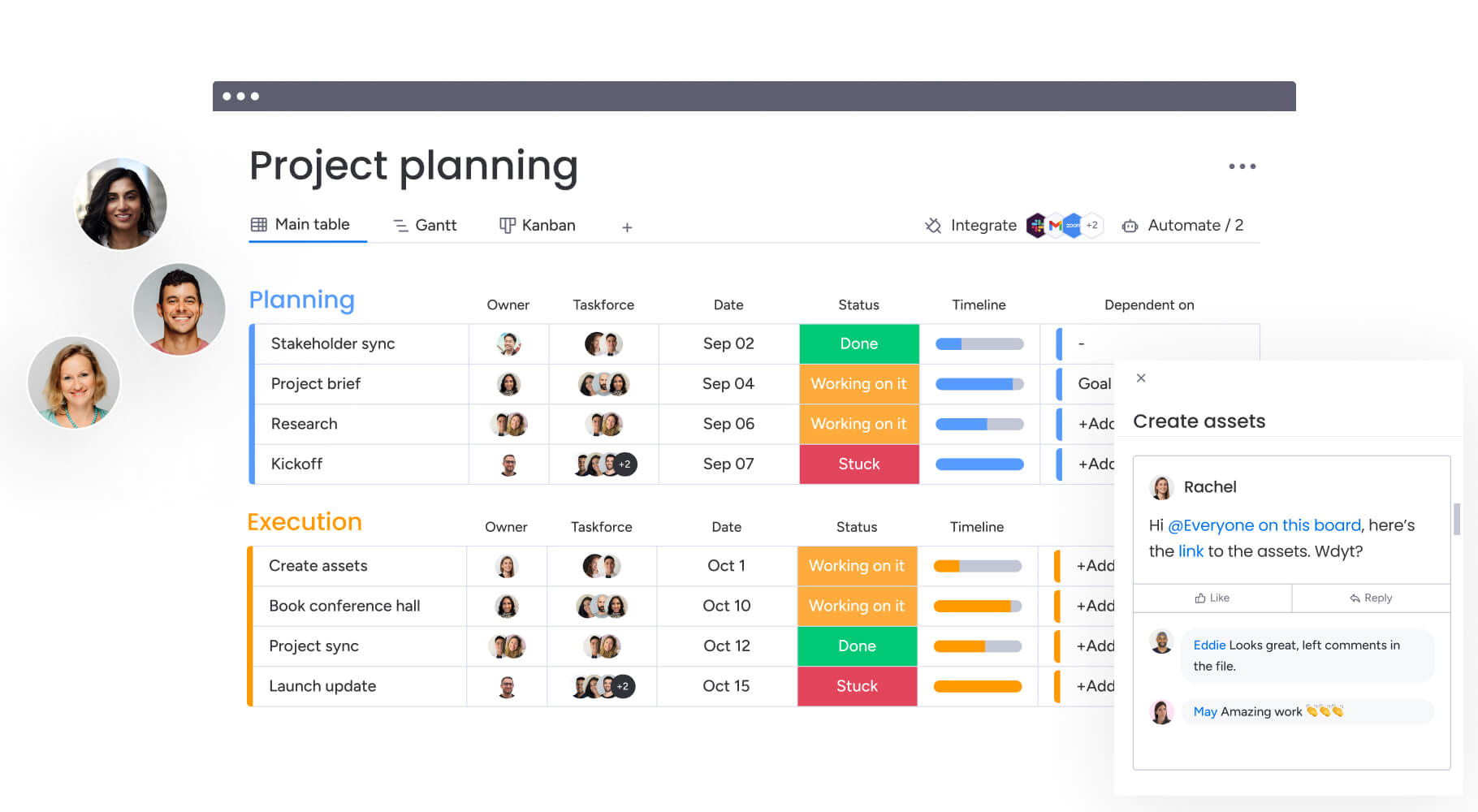Every successful project begins with clarity. Without a shared understanding of purpose, scope, and authority, even well-planned initiatives can quickly lose direction. A project charter creates that clarity by defining what the project aims to achieve, who is responsible for each part, and how success will be measured.
By setting these foundations early, a charter helps teams stay aligned, confident, and focused as the work progresses. It bridges the gap between planning and execution, guiding decisions and keeping everyone working toward the same goals. When used consistently, it becomes a trusted source of direction that keeps projects on track from kickoff to completion.
This article breaks down how to create an effective project charter and includes templates to help teams of any size start strong and stay organized.
Key takeaways
- Define clear authority: a project charter formally approves your work, prevents scope creep, and outlines deliverables, responsibilities, and success metrics.
- Include seven core components: vision, deliverables, scope boundaries, timeline, budget, stakeholder roles, and risk management, creating one reliable reference point that supports faster decisions.
- Save time with templates: use industry-specific frameworks that provide customizable structures covering every critical charter element.
- Enhance collaboration with monday work management: turn static documents into dynamic foundations through real-time updates, AI-driven task generation, and seamless planning-to-execution integration.
- Follow a proven five-step process: define the vision, map stakeholders, establish scope, set timelines, and identify risks to build alignment from the start.
What is a project charter?
A project charter is a formal document that authorizes a project to begin and gives the project manager authority to use organizational resources. It’s your project’s foundation — the single source of truth that everyone refers to when questions arise about scope in project management, authority, or purpose.
In simple terms it’s a contract between the project team and the organization. The charter captures why the project exists, what it will deliver, and who’s responsible for making it happen. Without this document, projects often drift from their original purpose or struggle with unclear boundaries — a major risk when large projects already run an average of 30% over budget, and are typically delivered up to a year behind schedule.

Key components of every project charter
Every project charter needs specific elements to guide your team from kick-off through completion. Missing any of these components can lead to confusion, delays, or scope creep down the line.
Project vision and objectives
Your vision statement captures the future state you’re working toward. Objectives break that vision into measurable outcomes that define success. These elements connect your project to broader organizational goals and help stakeholders understand why their support matters.
Deliverables and success criteria
Define exactly what your project will produce. List tangible outputs like reports, systems, or products alongside intangible outcomes like improved processes or trained teams. Success criteria specify how you’ll measure whether those deliverables meet expectations.
Scope and boundaries
Scope defines what’s included in your project — and just as important, what’s not. Well-defined boundaries prevent the endless additions that derail timelines and budgets. This section protects your team from scope creep while setting realistic stakeholder expectations.
Timeline and milestones
Include major dates without getting into detailed scheduling. Focus on key milestone chart elements that mark significant progress points. This high-level timeline helps stakeholders understand project duration and critical dependencies.
Budget and resources
Outline the financial investment and resources required for success. Cover both human resources and material needs like software, equipment, or facilities. Keep estimates high-level but realistic, which you can simplify with a budget proposal template.
Stakeholder roles and responsibilities
Identify everyone involved and define their participation level. Include decision-makers who approve major changes, contributors who do the work, and those impacted by project outcomes. Clear roles prevent the confusion that slows projects down, and are an essential part of project governance.
Risk management plan
List potential risks that could impact your project’s success. Include high-level mitigation strategies for each major risk. This proactive approach helps teams prepare for challenges before they become crises.

Who creates a project charter?
Developing a project charter is a collaborative effort that draws on multiple perspectives. Research shows that project success depends less on tools and technology and more on the alignment of social and technical complexities — a balance the project manager is responsible for coordinating. Every participant contributes insights that shape the final document and ensure it reflects both strategic and practical needs.
A strong charter typically involves:
- Project sponsor: provides the overall vision, secures funding, and ensures alignment with organizational goals. Their authority gives the charter its legitimacy and power.
- Project manager: drafts the document, gathers input from all contributors, and translates high-level direction into actionable components. Their role focuses on collaboration, creating a charter that works for everyone involved. If you are new to this process, it may help to explore project management for non-project managers.
- Key stakeholders: contribute requirements and insights based on their departments or areas of expertise. Their input helps define scope, priorities, and potential challenges.
- Subject matter experts: offer technical guidance and identify constraints that could affect execution, ensuring the charter is grounded in practical reality.
- End users: share the real-world needs and expectations the project must address, keeping the outcome focused on value.
- Senior leadership: reviews and approves the final version. Their sign-off transforms the charter from a working draft into an official mandate, signaling commitment and authorizing resource allocation.
When each role contributes effectively, the project charter becomes a balanced framework that connects strategic vision with operational execution.
7 project charter templates for modern teams
Different projects need different charter approaches. While core components stay consistent, emphasis shifts based on your industry, methodology, and organizational culture.
These project charter template resources provide starting points you can customize:
1. Agile project charter template
Designed for iterative development and changing requirements. Emphasizes flexibility within defined boundaries, continuous stakeholder feedback, and sprint-based delivery. Includes sections for product vision, user personas, and adaptation protocols.
2. Construction project charter template
Addresses permits, safety requirements, and regulatory compliance specific to construction. Covers site requirements, contractor coordination, environmental considerations, and quality standards. Built for projects with complex legal and safety obligations.
3. Marketing campaign charter template
Focuses on audience targeting, brand alignment, and measurable outcomes. Includes sections for campaign objectives, channel strategy, creative guidelines, and performance metrics. Designed for time-bound initiatives with specific market goals.
4. IT project charter template
Handles technical requirements, system integrations, and security protocols. Covers infrastructure needs, data migration plans, user training requirements, and rollout strategies. Built for technology implementations and upgrades.
5. Product development charter template
Supports innovation from concept through launch. Includes market research requirements, competitive analysis, feature prioritization, and go-to-market planning. Designed for bringing new products to market successfully.
6. Cross-functional team charter template
Manages coordination across departments. Addresses reporting structures, decision rights, communication protocols, and conflict resolution procedures. Essential for projects spanning multiple business units.
7. Remote team project charter template
Optimizes virtual collaboration across time zones. Covers technology requirements, communication standards, meeting schedules, and asynchronous work protocols. Built for distributed teams working together effectively.
How to create a project charter in 5 steps
Building an effective charter follows a logical sequence that gathers information, builds consensus, and creates a practical reference document. Each of the following steps builds on the previous one to create a comprehensive charter within an overarching project management process.
Step 1: define your project vision
Start with stakeholder interviews to understand different perspectives on the problem you’re solving. Document the business case that justifies investment. Connect your project to organizational goals to ensure strategic alignment.
Step 2: map stakeholders and team roles
Identify everyone who touches your project. Use stakeholder analysis to understand their influence and interest levels. Define specific responsibilities to prevent overlap and gaps in coverage.
Step 3: establish clear scope and deliverables
List what your project will produce. Be equally specific about what’s outside your scope. This boundary-setting prevents the feature creep that destroys timelines and budgets.
Step 4: set realistic timelines and budgets
Estimate duration and costs at a high level. Consider organizational constraints and resource availability. Build contingencies for unexpected challenges without padding excessively.
Step 5: identify risks and success metrics
Define how you’ll measure success beyond just completing deliverables, especially since employees who understand how success is measured are far more likely to feel motivated. List major risks with mitigation strategies. Include both quantitative metrics and qualitative success factors.

Project charter vs other documents
A project charter is just one part of your project documentation toolkit. Understanding how it differs from related materials ensures you create the right document for each stage.
While the charter authorizes the work and sets direction, other documents like the project plan, business case, and statement of work serve distinct purposes. The sections below outline how each compares and how they work together to keep projects aligned and on track.
Project charter vs project plan
A charter provides authorization and high-level direction. A project plan details execution specifics. Think of the charter as answering “what” and “why” while the plan addresses “how” and “when.”
The charter stays relatively stable throughout the project. The plan evolves constantly as you learn more and adapt to changes. Both documents work together but serve different audiences and purposes.
Project charter vs business case
The business case justifies why a project should exist. It demonstrates value and return on investment. The charter assumes that justification has been accepted and focuses on execution authorization.
Business cases come before project approval. Charters come after the decision to proceed. One sells the idea; the other launches the work.
Project charter vs statement of work
Statements of work define contractual obligations with external parties. They specify deliverables, payment terms, and legal responsibilities. Charters are internal documents that guide your team.
SOWs create binding agreements. Charters create organizational alignment. Both may exist for the same project but serve completely different functions.
Benefits of using project charter templates
Creating a project charter from scratch can feel overwhelming. Templates simplify the process by turning it into a guided, repeatable framework that helps teams start strong. They promote consistency, save time, and ensure every charter includes the right details: all essential elements of effective project management.
The sections below outline how templates streamline project initiation, accelerate kick-offs, and strengthen alignment across teams and stakeholders.
Standardize project initiation
Templates create a common language for project authorization across your organization. When every team uses the same format, stakeholders know exactly where to find critical information. This consistency reduces review time and improves understanding.
Accelerate project kick-offs
Starting with a proven structure eliminates guesswork. Teams focus on content instead of format, moving from approval to execution faster. Templates with prompts and examples make first-time charter creation manageable.
Ensure comprehensive documentation
Good templates include all essential elements, preventing costly oversights. They serve as checklists that guide teams through complete charter development. Nothing important gets forgotten when you follow a proven structure.
Improve team and stakeholder alignment
Standardized formats make review and approval more efficient. Stakeholders can quickly find the information they need to make decisions. This alignment reduces miscommunication and strengthens project support from day one, helping to bridge significant perception gaps between leadership and team members on key issues like shared ownership.

When to use a project charter template
Not every initiative needs a formal charter, but certain characteristics signal when documentation becomes valuable. Understanding these triggers helps you invest effort appropriately.
Consider creating a charter when your project involves:
- Multiple departments or teams: cross-functional work needs clear coordination.
- Significant budget allocation: major investments require formal authorization.
- Extended timelines: long projects need stable reference points.
- High organizational impact: changes affecting many people need clear communication.
- External stakeholders: vendors or partners need formal project definition.
- Regulatory requirements: compliance demands documented governance.
The effort invested in charter creation pays dividends through reduced confusion, faster decisions, and stronger stakeholder support throughout your project lifecycle.
Real project charter examples by industry
Seeing how different industries apply charter principles helps you understand how to adapt templates for your specific needs.
These helpful examples below show how the same core elements take different forms based on context, so reviewing a project charter example can guide you in adapting them.
Technology project charter example
A software implementation charter emphasizes system requirements and user adoption. The vision section describes operational improvements through automation. Scope defines which systems change and which remain untouched.
Timeline includes testing phases and rollout schedules. Resources cover both technical infrastructure and training needs. Success criteria focus on adoption rates, system performance, and process improvements.
Marketing project charter example
A product launch charter focuses on market positioning and customer engagement. Vision describes the market opportunity and brand impact. Scope defines target segments, channels, and campaign duration.
Resources include creative development, media budgets, and team allocation. Success metrics emphasize awareness levels, lead generation, and revenue impact. Risk management addresses competitive responses and market timing.
Operations project charter example
A process improvement charter targets efficiency gains and cost reduction. Vision describes streamlined operations and enhanced customer satisfaction. Scope identifies specific processes for redesign.
Timeline includes current state analysis, pilot testing, and full implementation. Success criteria focus on cycle time reduction, error rates, and cost savings. Stakeholders span multiple departments affected by process changes.
Transform project charters with monday work management
A project charter delivers real value when it moves from documentation to action. Many teams struggle to maintain that connection once work begins, causing the charter to fade into the background. monday work management keeps it central by transforming every charter into a living workspace that drives progress and accountability.
With a flexible project management template, teams can connect charter creation directly to execution. Real-time collaboration allows stakeholders to share input, updates, and approvals in one place, ensuring decisions stay transparent and momentum continues. Every version remains accessible, every update is tracked, and every detail aligns with the project’s objectives.
From automation and AI-powered insights to connected integrations and version control, monday work management provides the tools to keep every project aligned, adaptable, and moving forward with confidence.
Advanced automations for streamlined charter management
Eliminate manual updates and repetitive tasks with powerful automation recipes that keep your charter connected to execution. Set up triggers that maintain alignment as your project evolves:
- Status-based notifications: alert stakeholders when charter elements change.
- Dependency tracking: automatically update timelines when milestones shift,
- Approval workflows: route changes through designated decision-makers.
200+ integrations for connected charter ecosystems
Connect your project charter to every tool in your tech stack, creating a seamless information flow that keeps documentation and execution perfectly aligned:
- Document storage: sync with Google Drive, OneDrive, or Dropbox.
- Communication tools: push updates to Slack, Teams, or email.
- Development platforms: link charter items to GitHub, Jira, or Azure DevOps.
Powerful AI features for charter optimization
The platform’s AI capabilities enhance charter development through intelligent assistance that speeds creation and improves quality:
- Automated task generation: convert charter objectives into actionable project tasks.
- Smart summarization: create executive summaries from detailed charter content.
- Risk identification: flag potential issues based on project parameters.
- Resource matching: suggest team members based on skills and availability.
Charter governance and version control
Maintain charter integrity throughout your project lifecycle with robust governance features that preserve your single source of truth:
- Change tracking: document every modification with timestamps and rationale.
- Permission controls: define who can view or edit charter components.
- Audit trails: Access complete history of charter evolution for stakeholder reviews.
Integration capabilities connect your charter to project boards, dashboards, and reports. This connection ensures charter decisions flow seamlessly into daily work. Teams stay aligned with original objectives while maintaining flexibility to adapt.

Frequently asked questions
How long should a typical project charter be?
A typical project charter should be two to five pages long. This length provides enough detail to guide the project while remaining concise enough for busy executives to review quickly.
Does Word have a project charter template?
Word includes basic project charter templates in its template gallery. However, these generic templates often need significant customization to address specific industry needs and organizational requirements.
Can you update a project charter after approval?
You can update project charters after approval, but changes require formal review by the sponsor and key stakeholders. Modifications affecting scope, budget, or timeline need documented approval to maintain organizational support.
Do agile teams need project charters?
Agile teams benefit from project charters that establish vision and boundaries while allowing iterative planning for execution details. The charter provides stable direction that guides sprint planning and ensures strategic alignment.
